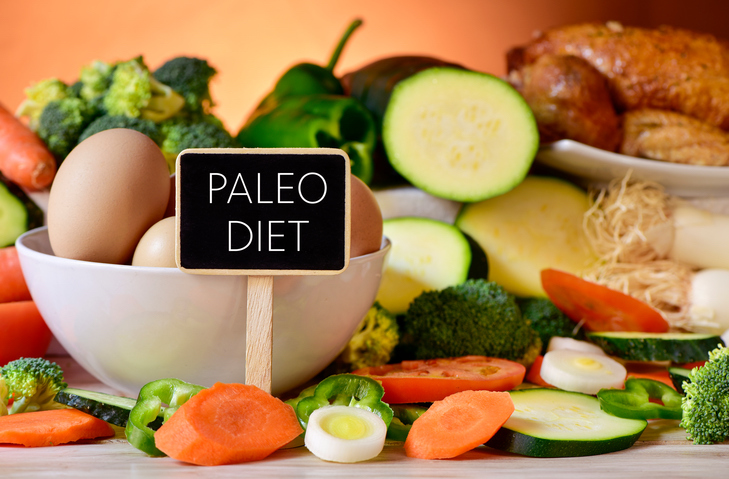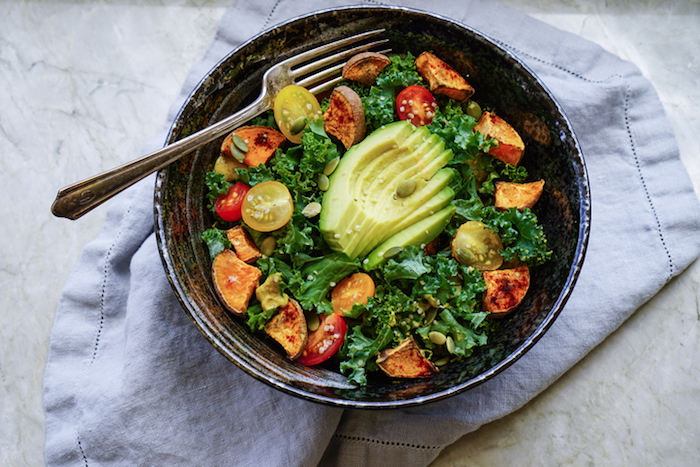Processed foods, pesticides, medications, and toxins damage the gut microbiome which in turn drives a range of digestive, autoimmune and neurological illness. Various “Healing diets” work to heal the gut and calm the immune system and vary depending on the gut, genetics and environment.
The Paleo Diet
 The Paleolithic Diet, known today as the modern Paleo Diet, originated from the ideas of a gastroenterologist in 1975, Dr. Walter Voegtlin.
The Paleolithic Diet, known today as the modern Paleo Diet, originated from the ideas of a gastroenterologist in 1975, Dr. Walter Voegtlin.
Later in 1985, Dr. Boyd Eaton wrote a scientific paper about Paleolithic nutrition, published in the New England Journal of Medicine. However, the diet has been made popular by Dr. Loren Cordain, founder of the Paleo Movement, in 2002.
Paleolithic Man
Referring to Dr. Boyd’s paper, some of the original points about the stone-age diet include:
- Pre-agricultural hunter-gatherers did not consume cereal grains
- Hunter-gatherers did not consume dairy products
- The breakdown of energy intake was as follows: 19-35% protein, 22-40% carbohydrates, and 28-58% fat
- Saturated fats contributed very minimally to the diet, at approximately 7.5%
- Polyunsaturated fats were high, however, the ratio of Omega 6 to Omega 3 fats were 2:1, compared to our ratios today of 20:1 or even higher
- Carbohydrates came from fruits and vegetables
Features of the Paleo Diet
The Paleo diet is based on the eating habits of our Paleolithic ancestors who lived between 2.5 million – 10,000 years ago.
The basic focus of the Paleo diet include:
- High Protein Intake
- Low Carbohydrate and low-glycemic index foods
- High fiber intake
- Medium to high fat intake
- High monounsaturated and polyunsaturated fats, balanced omega 3 to omega 6 ratio
- Higher potassium to sodium ratio
- High intake of vitamins, minerals, phytonutrients
Comparisons Between the Paleo Diet and the Standard Western Diet:
Paleo Diet |
Standard Western Diet |
|
|
Benefits of the Paleo Diet
 You are eating a clean diet that predominantly consists of fresh fruits, vegetables, and good quality meats. Processed foods are being omitted, along with preservatives, additives, and artificial flavorings.
You are eating a clean diet that predominantly consists of fresh fruits, vegetables, and good quality meats. Processed foods are being omitted, along with preservatives, additives, and artificial flavorings.- It can reduce inflammation due to the high phytonutrient content from the fruits, vegetables, raw oils, nuts and seeds. Grass fed meat, wild game, free-range eggs also contribute to the correct ratio of Omega 3 and 6 essential fatty acids.
- Increased satiety, due to the high protein and medium to high fat intake, keeping you feeling fuller for longer, and experiencing less hunger between meals.
- Curbing obesity. Weight management and maintenance can be an advantage of the paleo diet as it does not only support short-term weight loss, it aids in maintaining a sustained healthy weight.
- Improved glucose tolerance and insulin sensitivity can be extremely beneficial for those with diabetes and/or insulin resistance. The emphasis on eating low glycemic index foods along with high protein and fat intake aids in preventing drastic blood glucose fluctuations.
- Improved lipid profiles and lowers risk of cardiovascular disease, as the Paleo diet can aid in reducing total cholesterol levels, low-density lipoproteins (LDL), and triglycerides.
- Digestive support, through the elimination of grains and dairy products. Conditions such Irritable Bowel Syndrome (IBS), dyspepsia, and reflux may be ameliorated.
- It may help reverse anemia as the Paleo diet is rich in foods high in iron and Vitamin B12.
Challenges with the Paleo Diet
- The Paleo diet can be higher-priced to maintain
- As this diet excludes beans and legumes, it is not easy for vegetarians and/or vegans to follow.
- If you are an athlete or train heavily, the diet may be too low in carbohydrates to sustain you.
- If you rely heavily on dairy as your main source of calcium, it is essential to understand what alternative food sources act as good replacements for calcium found in dairy.
- The Paleo diet does not restrict salt intake, and this may be an issue for those with hypertension. However, with the correct guidance from a trained practitioner, and ensuring the proper balance of mineral intake through whole foods and good quality salts, you can address hypertension on a Paleo diet.
- It can take a long time to prepare foods as you begin to familiarize yourself with the Paleo diet.
- It can be difficult to dine out, eat at social events, etc…
What can be eaten and what is excluded from the Paleo Diet?
Included in PALEO |
Excluded from PALEO |
|
|
One Day in Your Life on the Paleo Diet:
Below are examples of meals that you could eat on the Paleo Diet:
Breakfast |
Lunch |
Dinner |
Snacks |
|
|
|
|
References:
Simopoulos AP, 2016, ‘An Increase in the Omega-6/Omega-3 Fatty Acid Ration Increases the Risk for Obesity’, Nutrients, 8(3), 128.
Eaton BS, Konner M, 1985, ‘Paleolithic Nutrition- A Consideration of Its Nature and Current Implications’, The New England Journal of Medicine, 312:283-289.
Otten J, Stomby A, Waling M, Isaksson A, Tellstrom A, Lundin-Olsson L, Brage S, Ryberg M, Svensson M, Olsson T, 2017, ‘Benefits of a Paleolithic diet with and without supervised exercise on fat mass, insulin sensitivity, and glycemic control: a randomized controlled trial in individuals with type 2 diabetes’, Diabetes Metabolism Research and Reviews, 33(1).
Pastore RL, Brooks JT, Carbone JW, 2015, ‘Paleolithic nutrition improves plasma lipid concentrations of hypercholesterolemic adults to a greater extent than traditional heart-healthy dietary recommendations’, Nutrition Research, 35(6), 474-9
Diet Profile Research and Writing: Kimberly Kushner BHSc (Nutritional Medicine), BHSc (Naturopathy) for MINDD
